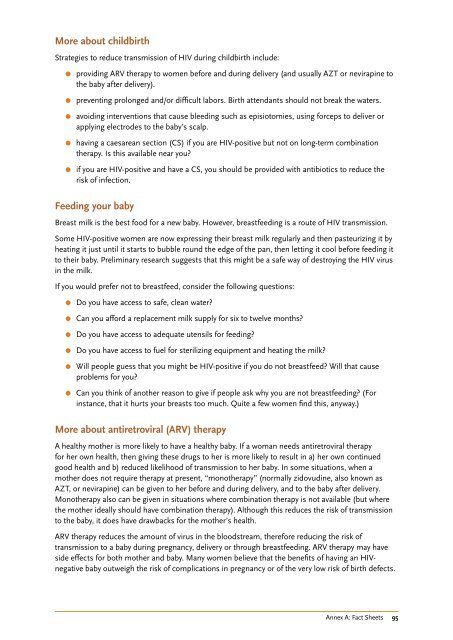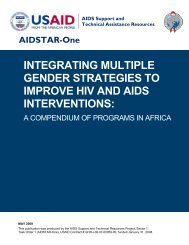Guide for Community Assessments on Women's Health Care - ICRW
Guide for Community Assessments on Women's Health Care - ICRW
Guide for Community Assessments on Women's Health Care - ICRW
You also want an ePaper? Increase the reach of your titles
YUMPU automatically turns print PDFs into web optimized ePapers that Google loves.
More about childbirth<br />
Strategies to reduce transmissi<strong>on</strong> of HIV during childbirth include:<br />
●●<br />
●●<br />
●●<br />
●●<br />
●●<br />
providing ARV therapy to women be<str<strong>on</strong>g>for</str<strong>on</strong>g>e and during delivery (and usually AZT or nevirapine to<br />
the baby after delivery).<br />
preventing prol<strong>on</strong>ged and/or difficult labors. Birth attendants should not break the waters.<br />
avoiding interventi<strong>on</strong>s that cause bleeding such as episiotomies, using <str<strong>on</strong>g>for</str<strong>on</strong>g>ceps to deliver or<br />
applying electrodes to the baby’s scalp.<br />
having a caesarean secti<strong>on</strong> (CS) if you are HIV-positive but not <strong>on</strong> l<strong>on</strong>g-term combinati<strong>on</strong><br />
therapy. Is this available near you?<br />
if you are HIV-positive and have a CS, you should be provided with antibiotics to reduce the<br />
risk of infecti<strong>on</strong>.<br />
Feeding your baby<br />
Breast milk is the best food <str<strong>on</strong>g>for</str<strong>on</strong>g> a new baby. However, breastfeeding is a route of HIV transmissi<strong>on</strong>.<br />
Some HIV-positive women are now expressing their breast milk regularly and then pasteurizing it by<br />
heating it just until it starts to bubble round the edge of the pan, then letting it cool be<str<strong>on</strong>g>for</str<strong>on</strong>g>e feeding it<br />
to their baby. Preliminary research suggests that this might be a safe way of destroying the HIV virus<br />
in the milk.<br />
If you would prefer not to breastfeed, c<strong>on</strong>sider the following questi<strong>on</strong>s:<br />
●●<br />
●●<br />
●●<br />
●●<br />
●●<br />
●●<br />
Do you have access to safe, clean water?<br />
Can you af<str<strong>on</strong>g>for</str<strong>on</strong>g>d a replacement milk supply <str<strong>on</strong>g>for</str<strong>on</strong>g> six to twelve m<strong>on</strong>ths?<br />
Do you have access to adequate utensils <str<strong>on</strong>g>for</str<strong>on</strong>g> feeding?<br />
Do you have access to fuel <str<strong>on</strong>g>for</str<strong>on</strong>g> sterilizing equipment and heating the milk?<br />
Will people guess that you might be HIV-positive if you do not breastfeed? Will that cause<br />
problems <str<strong>on</strong>g>for</str<strong>on</strong>g> you?<br />
Can you think of another reas<strong>on</strong> to give if people ask why you are not breastfeeding? (For<br />
instance, that it hurts your breasts too much. Quite a few women find this, anyway.)<br />
More about antiretroviral (ARV) therapy<br />
A healthy mother is more likely to have a healthy baby. If a woman needs antiretroviral therapy<br />
<str<strong>on</strong>g>for</str<strong>on</strong>g> her own health, then giving these drugs to her is more likely to result in a) her own c<strong>on</strong>tinued<br />
good health and b) reduced likelihood of transmissi<strong>on</strong> to her baby. In some situati<strong>on</strong>s, when a<br />
mother does not require therapy at present, “m<strong>on</strong>otherapy” (normally zidovudine, also known as<br />
AZT, or nevirapine) can be given to her be<str<strong>on</strong>g>for</str<strong>on</strong>g>e and during delivery, and to the baby after delivery.<br />
M<strong>on</strong>otherapy also can be given in situati<strong>on</strong>s where combinati<strong>on</strong> therapy is not available (but where<br />
the mother ideally should have combinati<strong>on</strong> therapy). Although this reduces the risk of transmissi<strong>on</strong><br />
to the baby, it does have drawbacks <str<strong>on</strong>g>for</str<strong>on</strong>g> the mother’s health.<br />
ARV therapy reduces the amount of virus in the bloodstream, there<str<strong>on</strong>g>for</str<strong>on</strong>g>e reducing the risk of<br />
transmissi<strong>on</strong> to a baby during pregnancy, delivery or through breastfeeding. ARV therapy may have<br />
side effects <str<strong>on</strong>g>for</str<strong>on</strong>g> both mother and baby. Many women believe that the benefits of having an HIVnegative<br />
baby outweigh the risk of complicati<strong>on</strong>s in pregnancy or of the very low risk of birth defects.<br />
Annex A: Fact Sheets 95

















